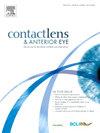Normative corneal biometric parameters in African populations: A systematic review and meta-analysis
IF 3.7
3区 医学
Q1 OPHTHALMOLOGY
引用次数: 0
Abstract
Background
Despite the importance of corneal biometric parameters in ophthalmology, there is limited comprehensive data on these measurements in Sub-Saharan African (SSA) populations. This study systematically reviewed the evidence on corneal biometric parameters of Sub-Saharan African populations, focusing on their variability, influencing factors, and implications for clinical practice and public health interventions.
Methods
A systematic review and meta-analysis were conducted following PRISMA guidelines. Eligible studies published between January 2003 and December 2023 were identified through comprehensive searches in PubMed, Scopus, and Web of Science, with a specific focus on African populations. Inclusion criteria comprised non-interventional studies reporting central corneal thickness (CCT), corneal curvature, radius of curvature, or horizontal corneal diameter (HCD) of eyes of continental Africans. Data were synthesized using random-effects meta-analyses, with heterogeneity assessed using the I2 statistic. Subgroup analyses examined variations by geographic region, measurement instrument, and sex.
Results
Twenty-eight studies with a total of 14,009 participants were included. The pooled mean CCT was 553.35 µm (95 % CI: 548.52–558.18 µm), with regional variations ranging from 555.66 µm in West Africa to 510.17 µm in Southern Africa. Males exhibited slightly higher CCT values compared to females (539.11 µm vs. 533.78 µm). Additional parameters assessed included mean corneal curvature (43.07 D), radius of curvature (7.70 mm), and HCD (11.59 mm). Variability in the measurements was attributed to demographic, geographic, and methodological factors.
Conclusions
Corneal biometric parameters exhibit substantial regional and demographic variability in SSA. These findings underscore the importance of population-specific data in enhancing diagnostic precision and guiding the development of regionally tailored clinical protocols. Further research is needed to address current knowledge gaps and improve eye care outcomes across the African continent.
Funding
This research received no specific grant from funding agencies in the public, commercial, or not-for-profit sectors.
撒哈拉以南非洲人群的规范角膜生物特征参数:系统回顾和荟萃分析。
背景:尽管角膜生物特征参数在眼科中的重要性,但在撒哈拉以南非洲(SSA)人群中,关于这些测量的综合数据有限。本研究系统地回顾了撒哈拉以南非洲人群角膜生物特征参数的证据,重点关注其变异性、影响因素以及对临床实践和公共卫生干预的影响。方法:根据PRISMA指南进行系统评价和荟萃分析。2003年1月至2023年12月期间发表的符合条件的研究通过PubMed、Scopus和Web of Science的综合搜索确定,特别关注非洲人口。纳入标准包括报告非洲大陆人眼睛角膜中央厚度(CCT)、角膜曲率、曲率半径或角膜水平直径(HCD)的非介入性研究。采用随机效应荟萃分析综合数据,采用I2统计量评估异质性。亚组分析考察了地理区域、测量工具和性别的差异。结果:共纳入28项研究,14009名受试者。综合平均CCT为553.35µm (95% CI: 548.52-558.18µm),区域差异从西非的555.66µm到南部非洲的510.17µm不等。男性的CCT值略高于女性(539.11µm比533.78µm)。评估的其他参数包括平均角膜曲率(43.07 D)、曲率半径(7.70 mm)和HCD (11.59 mm)。测量结果的可变性归因于人口统计学、地理和方法因素。结论:角膜生物特征参数在SSA中表现出明显的区域和人口差异。这些发现强调了特定人群数据在提高诊断准确性和指导制定适合区域的临床方案方面的重要性。需要进一步的研究来解决目前的知识差距并改善整个非洲大陆的眼科保健结果。资助:本研究未获得公共、商业或非营利部门资助机构的特别资助。
本文章由计算机程序翻译,如有差异,请以英文原文为准。
求助全文
约1分钟内获得全文
求助全文
来源期刊

Contact Lens & Anterior Eye
OPHTHALMOLOGY-
CiteScore
7.60
自引率
18.80%
发文量
198
审稿时长
55 days
期刊介绍:
Contact Lens & Anterior Eye is a research-based journal covering all aspects of contact lens theory and practice, including original articles on invention and innovations, as well as the regular features of: Case Reports; Literary Reviews; Editorials; Instrumentation and Techniques and Dates of Professional Meetings.
 求助内容:
求助内容: 应助结果提醒方式:
应助结果提醒方式:


